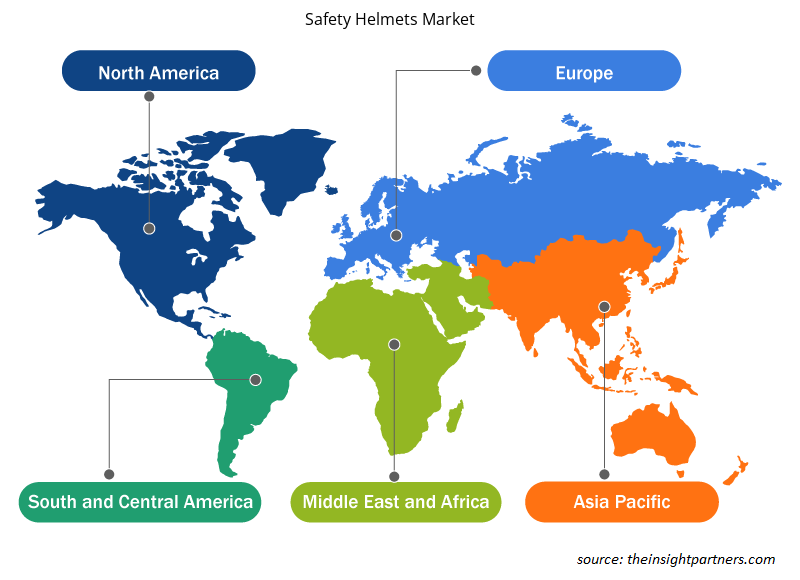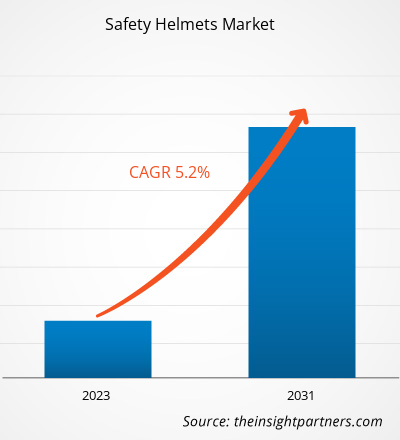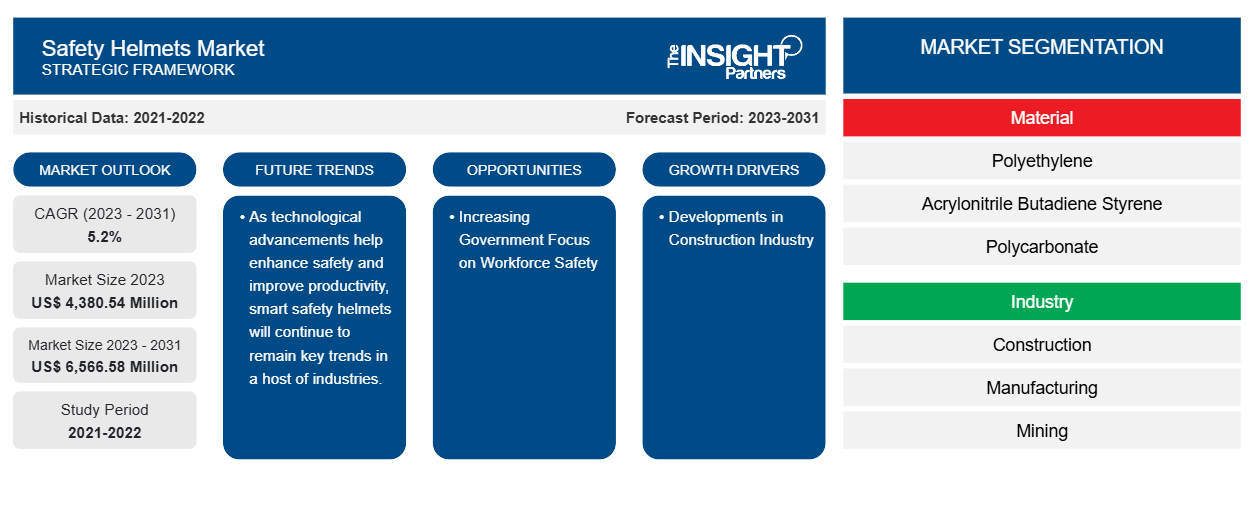安全头盔市场规模预计将从 2023 年的 43.8054 亿美元增至 2031 年的 65.6658 亿美元。预计 2023-2031 年期间,该市场的复合年增长率将达到 5.2%。随着技术进步有助于提高安全性和提高生产率,智能安全头盔将继续成为众多行业的主要趋势。
安全帽市场分析
劳动密集型行业要求采取适当的劳动力安全措施来降低风险水平;如果忽视这些措施,可能会导致各种危险情况,从而影响整个项目的时间表和运营效率。因此,高度重视安全措施,以避免与劳动力健康和安全相关的任何不必要的挑战。
城市化进程加快和人口增长促进了建筑业的发展,进而对安全帽市场产生了积极影响。石油和天然气行业为石油生产和采矿开采提供动力的不断进步以及用于发电的风力发电场数量的增加也推动了安全帽市场的扩张。
安全头盔市场概况
多年来,安全帽作为保护劳动力的基本必需品,其接受度不断提高。需要工人在高空或高风险环境中作业的行业推动了全球对安全帽的需求。同样,采矿业和电信业在安全措施方面投入了大量资金,这反过来又加速了对安全帽的需求。政府不断增加的举措和严格的法规的整合,以纳入高标准的劳动力安全措施,是全球安全帽市场的其他主要增长动力。安全帽市场前景继续乐观,因为这些头盔非常适合满足建筑、制造、石油和天然气、公用事业、电信和采矿等终端用户行业的安全要求。
定制此报告以满足您的需求
您可以免费定制任何报告,包括本报告的部分内容、国家级分析、Excel 数据包,以及为初创企业和大学提供优惠和折扣
-
获取此报告的关键市场趋势。这个免费样品将包括数据分析,从市场趋势到估计和预测。
安全头盔市场驱动因素和机遇
建筑业的发展
随着建筑行业的扩张和发展,安全操作的要求变得至关重要。各种类型的基础设施开发项目正在增加,例如商业综合体、住宅楼和工业设施。每个项目都需要劳动力进行建设、维修、维护和翻新。快速的城市化和人口激增推动了对新住房、商业空间和基础设施的需求。例如,沙特阿拉伯预计将成为世界上最大的建筑工地之一,在基础设施和房地产项目的投资约为 1.1 万亿美元。这些基础设施和房地产开发项目包括萨勒曼国王公园、Neom 超级城市、德拉伊耶门、红海项目以及吉达中心和吉达经济城项目。
随着城市的发展,高层建筑和大型项目的建设需要安全措施,以确保施工安全高效。具有具有挑战性的建筑设计或特定要求的独特项目需要定制的安全措施。例如,2023 年 3 月,加拿大基洛纳市议会宣布批准为基洛纳机场航站楼扩建项目提供 9000 万美元的资金。此外,2022 年,印度政府启动了到 2025 年底建设 220 个机场的项目。基础设施开发和房地产(包括商业、住宅和混合用途项目)的不断发展推动了对施工和维护活动期间安全工具(包括头盔)的需求。
政府越来越重视劳动力安全
职业事故的增多是阻碍任何建筑项目顺利进行的主要因素之一。适当的劳动力管理和日益采用标准安全措施以防止工作场所事故预计将有利于全球安全帽市场。一些国家的政府高度重视劳动力安全法规,以避免事故发生。1970 年的《职业安全与健康法》提到了适当的工作标准和条件,以确保劳动力安全。卫生与安全执行局 (HSE) 的《1974 年工作健康与安全法》还描述了预防工作相关伤害、疾病和死亡的措施。在印度,工作场所安全主要由《工厂法》(1948 年)和《矿山法》(1952 年)管理。此外,还有许多其他法律、政策、法规和指南与专业行业和部门有关。因此,预计在预测期内,政府不断增加的举措和保护劳动力安全措施的严格法规的出台将为安全帽市场提供丰厚的机会。
安全头盔市场报告细分分析
有助于得出安全头盔市场分析的关键部分是材料和行业。
- 根据材料,安全头盔市场分为聚乙烯、丙烯腈丁二烯苯乙烯、聚碳酸酯等。其中,聚乙烯在 2023 年占据最大份额,这得益于其在不断增长的建筑行业中的需求不断增加。
- 就行业而言,市场分为建筑业、制造业、采矿业和其他行业。其中,建筑业在 2023 年占据了最大份额,因为全球住宅和商业建筑项目对安全头盔的需求很大。
安全头盔市场份额按地区分析
安全头盔市场报告的地理范围主要分为五个地区:北美、亚太、欧洲、中东和非洲、南美和中美。
2023 年,亚太地区在安全头盔市场占据主导地位;由于建筑业的发展、政府对基础设施建设的重视程度不断提高、对翻新和维修工作的需求不断增加以及快速的城市化等因素,亚太地区将在预测期内继续占据市场主导地位。中国、印度和日本在亚太地区的安全头盔市场占有重要地位。
安全头盔市场区域洞察
Insight Partners 的分析师已详细解释了预测期内影响安全头盔市场的区域趋势和因素。本节还讨论了北美、欧洲、亚太地区、中东和非洲以及南美和中美洲的安全头盔市场细分和地理位置。

- 获取安全头盔市场的区域特定数据
安全头盔市场报告范围
| 报告属性 | 细节 |
|---|---|
| 2023 年的市场规模 | 43.8054亿美元 |
| 2031 年市场规模 | 65.6658亿美元 |
| 全球复合年增长率(2023 - 2031) | 5.2% |
| 史料 | 2021-2022 |
| 预测期 | 2023-2031 |
| 涵盖的领域 |
按材质
|
| 覆盖地区和国家 |
北美
|
| 市场领导者和主要公司简介 |
|
安全头盔市场参与者密度:了解其对业务动态的影响
安全头盔市场正在快速增长,这得益于终端用户需求的不断增长,而这些需求又源于消费者偏好的不断变化、技术进步以及对产品优势的认识不断提高等因素。随着需求的增加,企业正在扩大其产品范围,进行创新以满足消费者的需求,并利用新兴趋势,从而进一步推动市场增长。
市场参与者密度是指在特定市场或行业内运营的企业或公司的分布情况。它表明在给定市场空间中,相对于其规模或总市场价值,有多少竞争对手(市场参与者)存在。
在安全头盔市场运营的主要公司有:
- 3M 公司
- 霍尼韦尔国际公司
- MSA 安全公司
- Centurion 安全产品有限公司
- 康科德头盔与安全产品私人有限公司
- 捷星有限公司
免责声明:上面列出的公司没有按照任何特定顺序排列。

- 了解安全头盔市场顶级关键参与者概况
安全头盔市场新闻和最新发展
安全头盔市场通过收集一手和二手研究后的定性和定量数据进行评估,其中包括重要的公司出版物、协会数据和数据库。安全头盔市场的一些发展情况如下:
- STUDSON 是一家安全头盔开发商,最近推出了首款全帽檐 ANSI II 型安全头盔,该公司宣布完成 248 万美元融资,并与欧洲最大的工作服生产商之一 Blaklader 达成战略合作。(来源:STUDSON,公司新闻稿,2024 年 3 月)
- Lakeland Industries, Inc. (NASDAQ:LAKE)(以下简称“公司”或“Lakeland”)是一家全球领先的工业、医疗保健和联邦、州和地方急救人员防护服制造商,今天宣布以全现金方式收购新西兰的 Pacific Helmets NZ Limited(以下简称“Pacific”),交易价值约为 850 万美元,但须遵守交易后调整和惯例保留条款。(来源:STUDSON,公司新闻稿,2023 年 11 月)
安全头盔市场报告范围和交付成果
“安全头盔市场规模和预测(2021-2031)”报告对以下领域进行了详细的市场分析:
- 安全头盔市场规模及全球、区域和国家层面所有主要细分市场的预测
- 安全头盔市场趋势以及市场动态,如驱动因素、限制因素和关键机遇
- 详细的 PEST 和 SWOT 分析
- 安全头盔市场分析涵盖主要市场趋势、全球和区域框架、主要参与者、法规和最新市场发展
- 行业格局和竞争分析,涵盖市场集中度、热点图分析、知名参与者以及安全头盔市场的最新发展
- 详细的公司简介
- 历史分析(2 年)、基准年、预测(7 年)及复合年增长率
- PEST和SWOT分析
- 市场规模、价值/数量 - 全球、区域、国家
- 行业和竞争格局
- Excel 数据集
近期报告
相关报告
客户评价
购买理由
- 明智的决策
- 了解市场动态
- 竞争分析
- 客户洞察
- 市场预测
- 风险规避
- 战略规划
- 投资论证
- 识别新兴市场
- 优化营销策略
- 提升运营效率
- 顺应监管趋势























 获取免费样品 - 安全帽市场
获取免费样品 - 安全帽市场